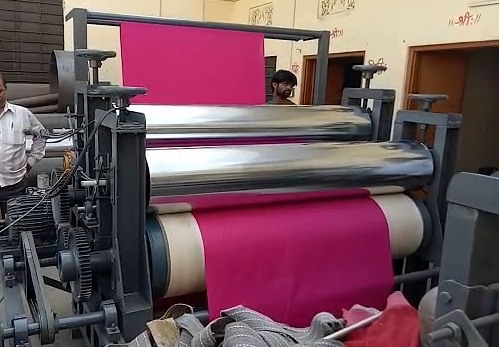CALENDERING FINISHING PROCESS:-
Calendering Finshing process:-
The principal object of finishing fabric is to confer a more pleasing appearance and handle or to render the fabric more suitable for a particular end use. Generally there are two types of finishing process in textile; mechanical finishing and chemical finishing. The mechanical treatments are significantly affected by the extent of heat and pressure applied, the moisture content of the material during the treatments and on the pretreatment of the fabric with gum and starchy products. Calendering is a mechanical finishing process which are widely used in textile industry. Calendering plays an important role in the appearance of the final fabric. It increases the marketability of the fabrics.
Calendering is a process whereby fabric is compressed by passing it between two or more rollers under controlled conditions of time, temperature and pressure in order to alter its handle, surface texture and appearance. Calendering is an operation carried out on a fabric to improve its aesthetics. It is a mechanical finishing process used on cloth where fabric is folded in half and passed under rollers at high temperatures and pressures. Calendering is used on fabrics such as moire to produce its watered effect and also on cambric and some types of sateens.
We already know that calendering is a type of mechanical levelling and segmenting process for ‘finishing’ fabrics or webs to produce a special effect, namely flattening, luster, compacting, glazing, moiré, Schreiner, smoothing, texturing and other embossed patterns by passing in open width between two adjacent rollers kept under pressure. The passage of material (full-width piece goods) between two rollers is called nip.
Calendaring is a high speed ironing process that primarily imparts luster and is usually the final treatment for the fabrics in the finishing sequence. The basic principle of calendaring is to expose the cloth to the combined effect of moisture, heat and pressure until the fabric acquires a very smooth and light reflecting surface and gets a good luster. The calendaring effect on the fabric is usually temporary and disappears after first washing. Semi permanent luster is sometimes achieved by padding fabric in a sparingly soluble polyvinyl acetate emulsion before calendaring, where the solution acts as a binding agent. More permanent finish can be obtained by treating fabric with a solution of crease recovery reagent, followed by drying, calendaring and curing the fabric at about 150ºC. The calendars are basically an assembly of heavy rolls, alternatively of iron and paper or cotton that are normally mounted in vertical frames. The rolls are bearing one on the other under a high pressure that is applied by compound levers or hydraulic or pneumatic equipment.
Paper or cotton rolls are made by compressing sheets of paper and cotton under heavy pressure of hundreds of tons and then finely turned to produce a smooth surface. The iron rolls are also called chilled rolls because these are hardened by sudden chilling of the red-hot rolls. These are hollow so as to allow passage of steam or sometimes gas-fire to heat these two different temperatures.
Objectives/Purpose of Calendering Finishing:-
The major changes to the fabric induced by the calendering process are,
(1) reduced fabric thickness,
(2) increased fabric luster,
(3) increased fabric cover,
(4) smooth silky surface feel,
(5) reduced air porosity, and
(6) reduced yarn slippage.
Main Purpose of Caledering Finishing Process of Caledering Finishing Process are given below:-
1) To upgrade the fabric hand and to impart a smooth silky touch to the fabric.
2) To improve the opacity of the fabric
3) To compress the fabric and reduce its thickness.
4) To impart different degree of luster to the fabric.
5) To reduce yarn slippage.
6) To give different visual and feel effects on the fabric
7 The mechanical finish is done for softness and shining of the fabric or stiffness according to the nature of the chemical, this process is done after the chemical finishing as per buyer requirement.
Parameters 0f Calendering Finishing Process:-
Some of the parameters affecting the calendering process are as follows:
1)Fabric construction.
2) Fiber content.
3) Finish applied.
4) Moisture content.
5) Temperature of the calender bowls.
6)Running speed.
7) Differential bowl speed – degree or ratio of friction.
8) Pressure applied.
9) Bowl composition.
Effects of Calendering Finishing Process:-
a) Reduction in fabric thickness.
b)Compaction of the weave structure –
alteration to the fabric porosity.
c)Change in the handle – softening effect, stiffening effect.
d) Change in appearance – effect on lustre
Types of Calenders in Textile:-
This non-permanent mechanical finishing treatment is applied to fabrics made of cellulose, protein and synthetic fibers, by means of a calender. There are various calender types, including embossing calenders, friction calenders, swissing calenders, chase calenders, and compaction calenders. The difference between them is determined by the number of rollers and the drive system.
The use of different types of caleders gives different effectc such as:-
1)Sheen appearance:
It can be obtained by smoothing the cloth surface, which ensures a better reflection of light.
2) Better coverage:
It is due to the compression of the cloth, which generates a flattening of each single yarn.
3) Softer hand:
It is obtained thanks to a slight ironing effect, which produces a smoother, and softer cloth surface.
4) Surface patterns:
They can be obtained by means of special effects (“embossing” for example) for decorative purposes or to modify the surface smoothness.
5) Yarn swelling and rounding effect:
They give a modest glaze finishing to the fabric, a surface smoothness and above all a full and soft hand.
Ref:-https://textileleaner.net





Comments
Post a Comment